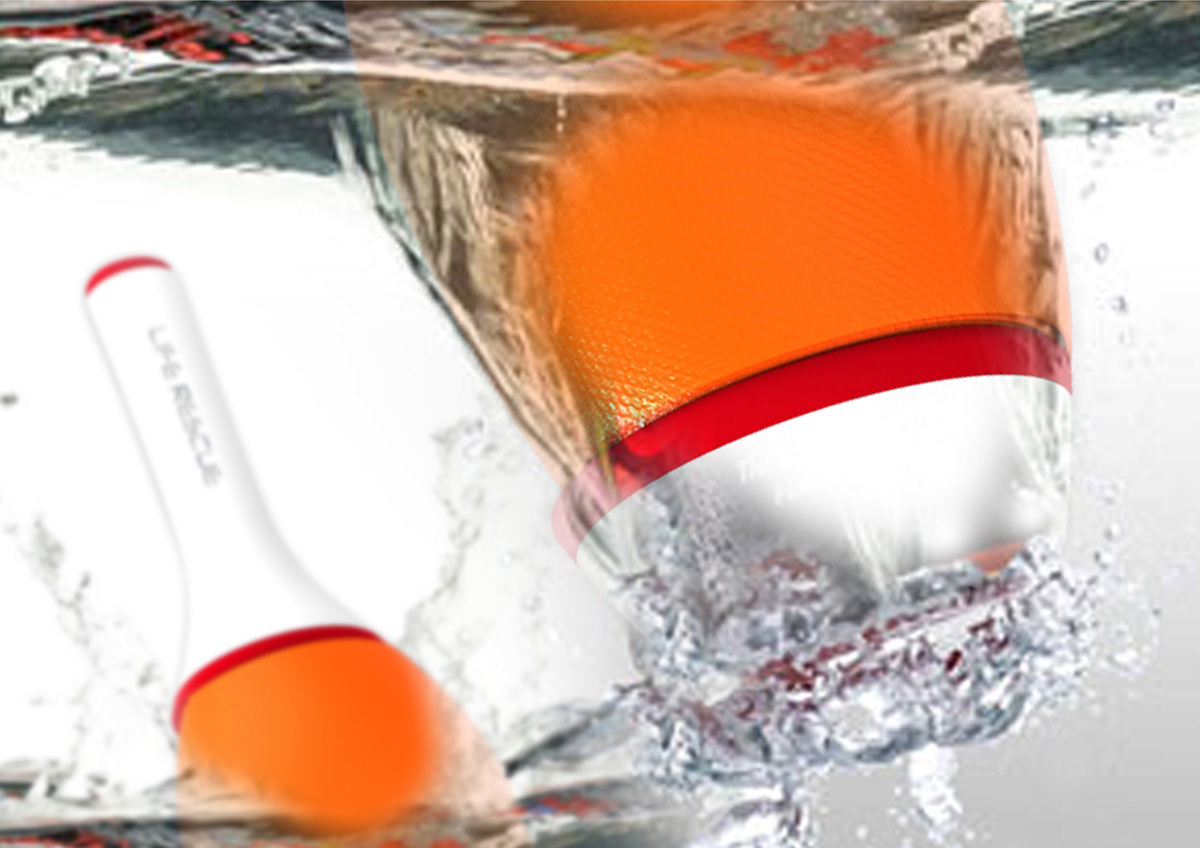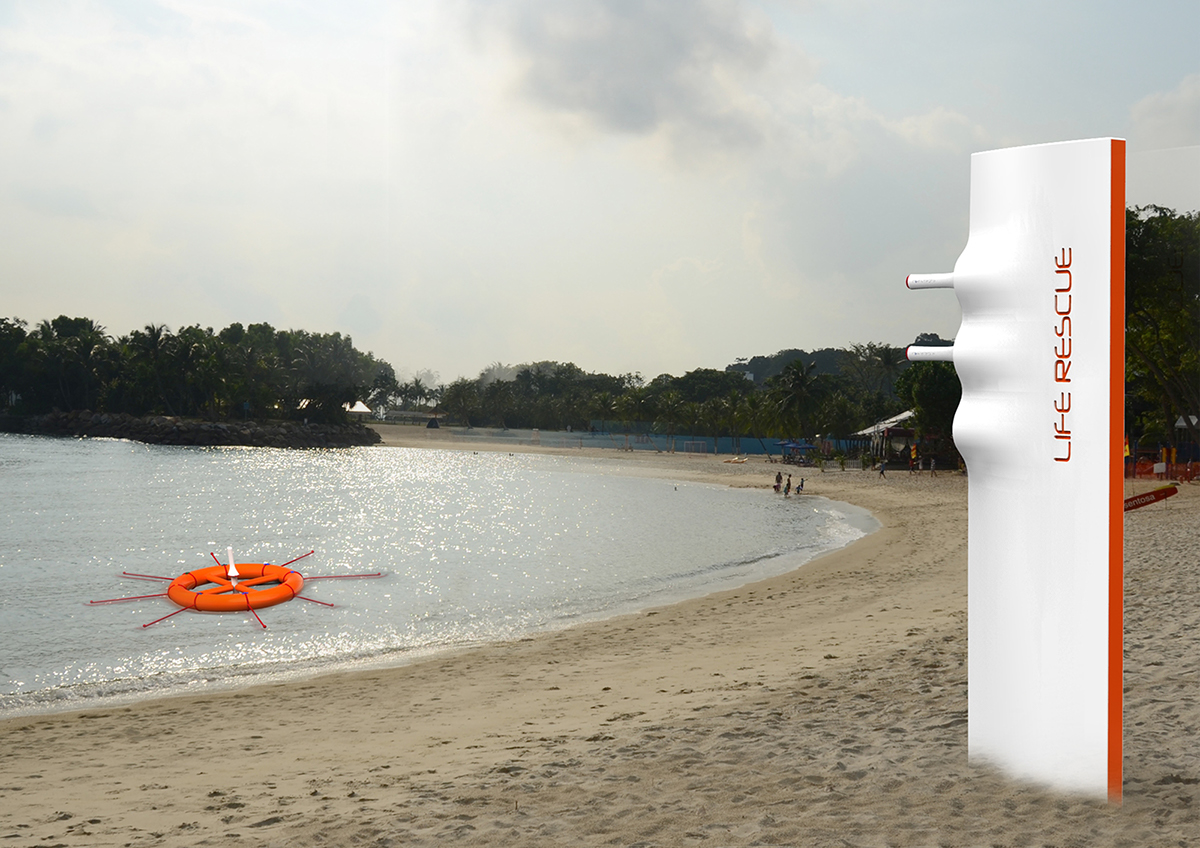
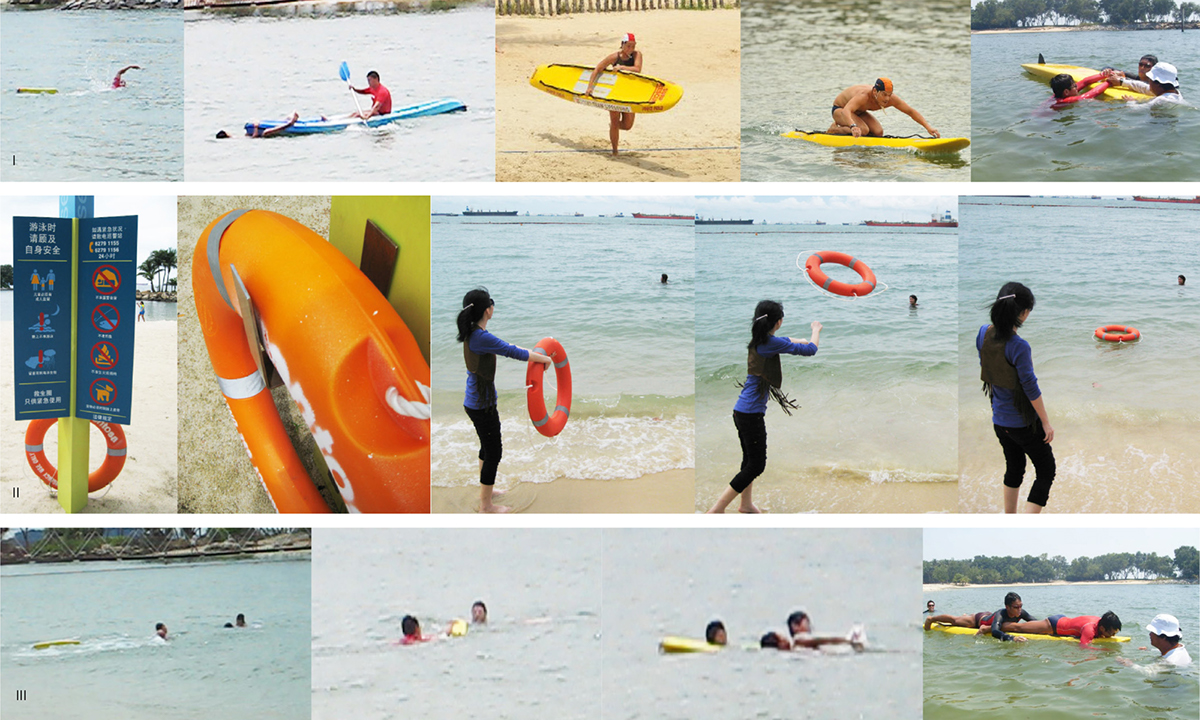
Identifying Insights
I. Physical limitations of victim and lifesaver
• Efficiency of rescue highly dependent on lifesaver’s physical fitness level.
•The only rescue equipment that passersby have access to is the lifebuoy. Inexperienced passersby are likely to encounter difficulty in throwing and aiming at the victim. One also cannot ensure that the victim can grab hold of the lifebuoy and get to safety.
III. Personal safety of lifesaver being compromised
• Under the guide to emergency procedure, the first consideration of water rescue should be the lifesaver’s safety.
I. Physical limitations of victim and lifesaver
• Efficiency of rescue highly dependent on lifesaver’s physical fitness level.
• The victim is required to use additional effort to hold onto equipment when he/she might already have exhausted all of it from struggling in the water.
• Once the victim feels a strain in energy, he/she may be entirely dependent both physically and mentally on the lifesaver, adding to the burden of the lifesaver.
II. Limitation of inexperienced passerby's
II. Limitation of inexperienced passerby's
•The only rescue equipment that passersby have access to is the lifebuoy. Inexperienced passersby are likely to encounter difficulty in throwing and aiming at the victim. One also cannot ensure that the victim can grab hold of the lifebuoy and get to safety.
III. Personal safety of lifesaver being compromised
• Under the guide to emergency procedure, the first consideration of water rescue should be the lifesaver’s safety.
• Rescues that can be performed without entering the water are the safest. However in the cases of rescue at open water, lifesavers need to enter the water to attempt an efficient rescue.
• Personal safety of lifesaver is associated with how a victim reacts in terms of emergency. A struggling victim may endanger the safety of the lifesaver during rescue.
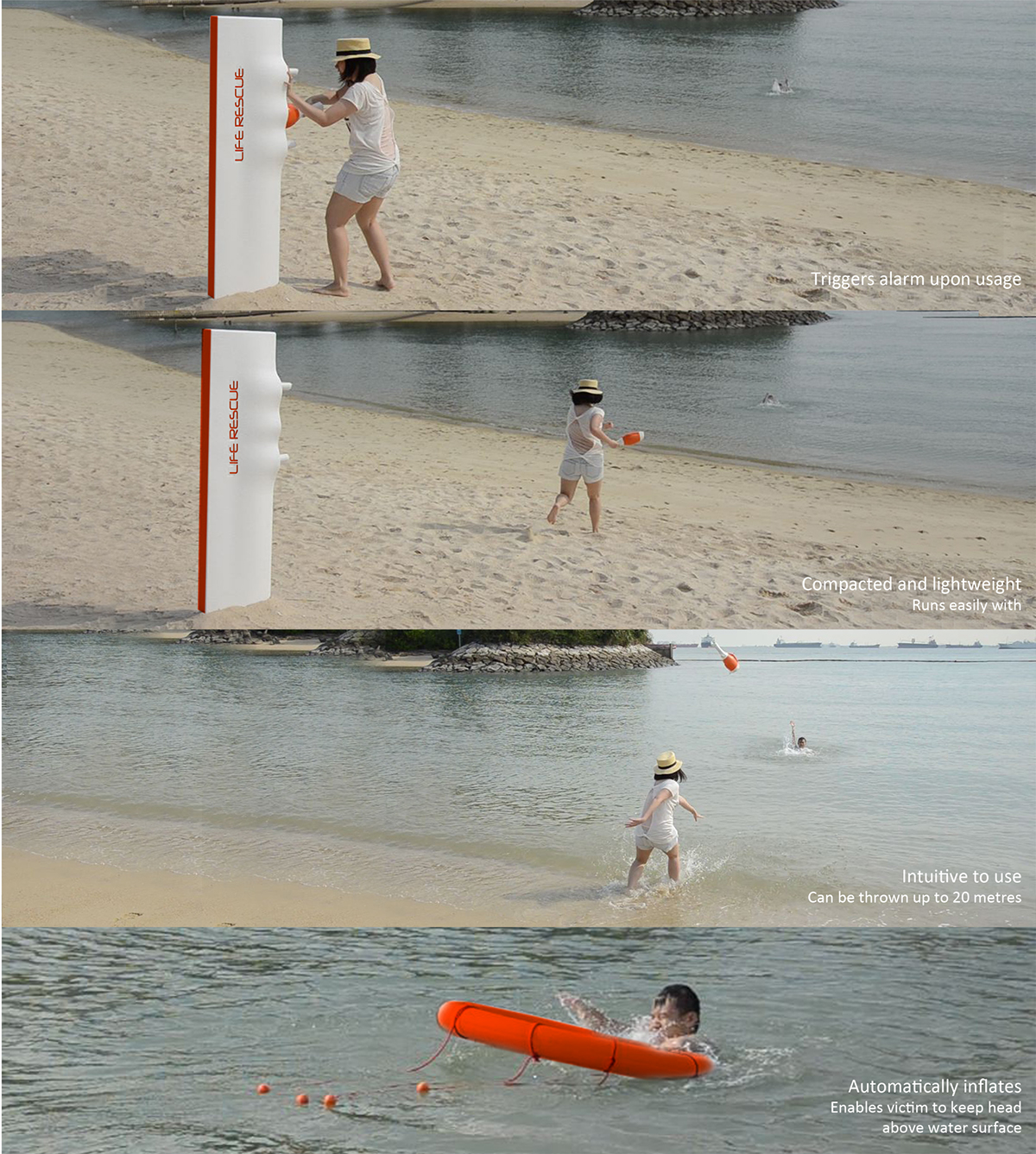
Scenario
The compacted and lightweight water rescue equipment enables both the inexperienced and experienced to execute efficient water rescue. When one removes a lifebuoy from the lifebuoy stand, an alarm is triggered and the lifeguard house is informed of the incident at that particular spot.
Unless rescued by a trained lifeguard, the drowning victims can only struggle on the surface of the water from 20 to 60 seconds before submersion occurs. On average, it takes approximately 6 - 9 minutes for the brain without oxygen to have irreversible damage. A person may go unconscious sooner with water in their lungs. But once the brain dies, all bodily functions stop, and cannot be revived.
The water rescue equipment provides a quick and effective primary aid for the victim, helping the victim to keep his head above the water surface at the critical moment.
The compacted and lightweight water rescue equipment enables both the inexperienced and experienced to execute efficient water rescue. When one removes a lifebuoy from the lifebuoy stand, an alarm is triggered and the lifeguard house is informed of the incident at that particular spot.
Unless rescued by a trained lifeguard, the drowning victims can only struggle on the surface of the water from 20 to 60 seconds before submersion occurs. On average, it takes approximately 6 - 9 minutes for the brain without oxygen to have irreversible damage. A person may go unconscious sooner with water in their lungs. But once the brain dies, all bodily functions stop, and cannot be revived.
The water rescue equipment provides a quick and effective primary aid for the victim, helping the victim to keep his head above the water surface at the critical moment.
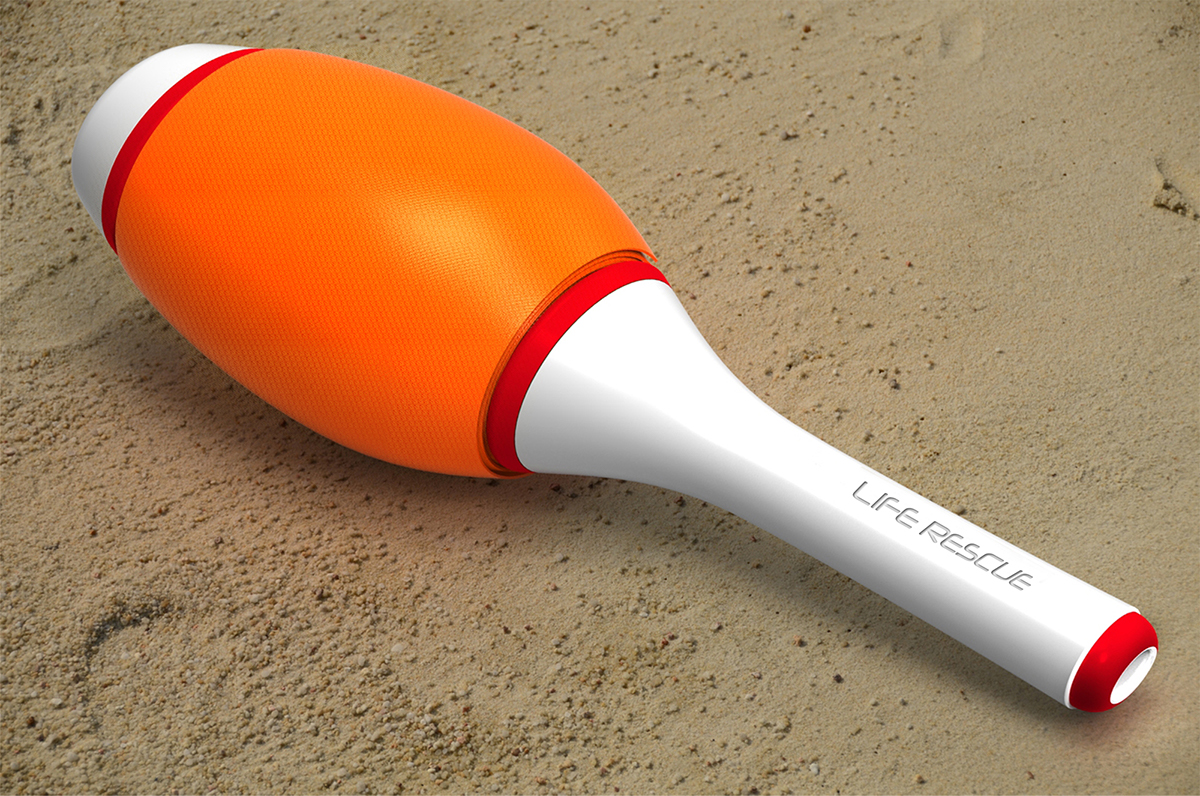
The Compacted Lifebuoy
Explorations of the form of the compacted lifebuoy and its mechanism carried on throughout the project, in search of the optimum result. Sketches relating to the form of the compacted lifebuoy were translated to models for user-testing.
Explorations of the form of the compacted lifebuoy and its mechanism carried on throughout the project, in search of the optimum result. Sketches relating to the form of the compacted lifebuoy were translated to models for user-testing.
The initial round of testing includes various forms and shapes (ball, discus, donut, bottle etc). The focus is then brought to the bottle shape which it produce the most effective result. Holding a bottle, it mimics grabbing of a handle, which allows users to throw far and aiming effectively near the victim.
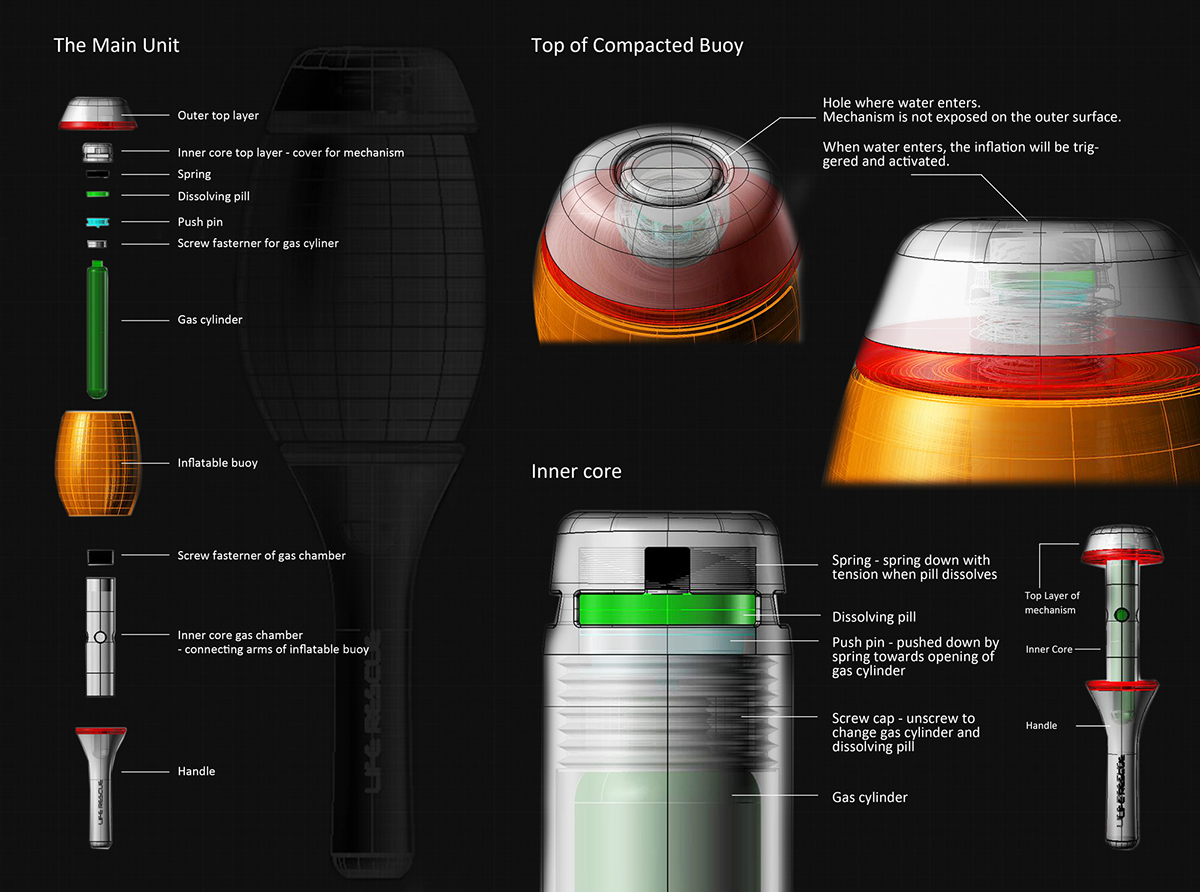
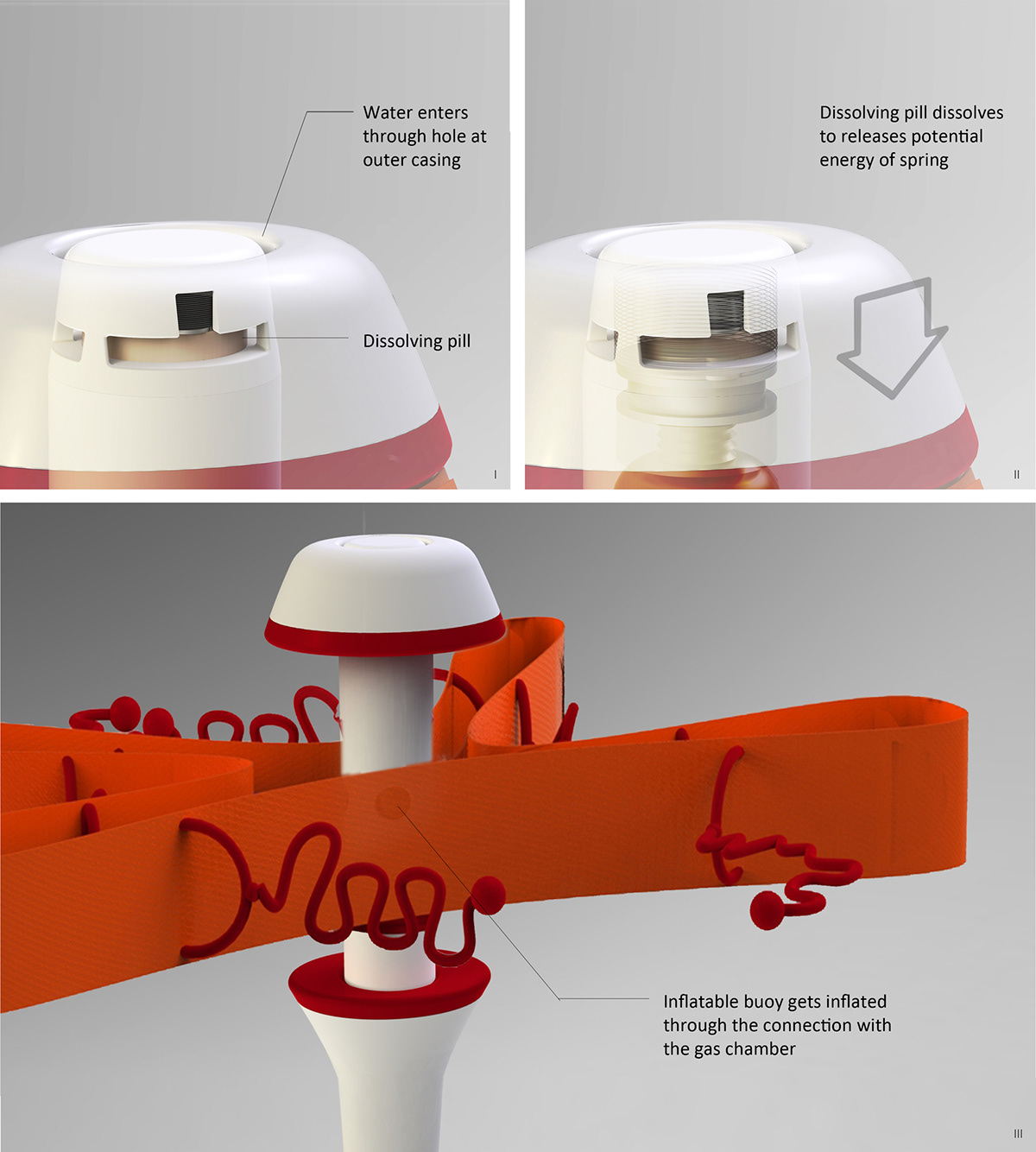
The Mechanism
When the compacted lifebuoy lands on water, water seeps in through the hole at the top of the compacted lifebuoy. The dissolving pill in the inner core dissolves to release the potential energy of a spring; which in turn triggers the “firing” of the pin towards the gas cylinder.
The gas cylinder inflates the inflatable lifebuoy which is wrapped around the handle. The bold attempt of wrapping the inflatable buoy as the outer layer helps make the water rescue more efficient.
When the compacted lifebuoy lands on water, water seeps in through the hole at the top of the compacted lifebuoy. The dissolving pill in the inner core dissolves to release the potential energy of a spring; which in turn triggers the “firing” of the pin towards the gas cylinder.
The gas cylinder inflates the inflatable lifebuoy which is wrapped around the handle. The bold attempt of wrapping the inflatable buoy as the outer layer helps make the water rescue more efficient.
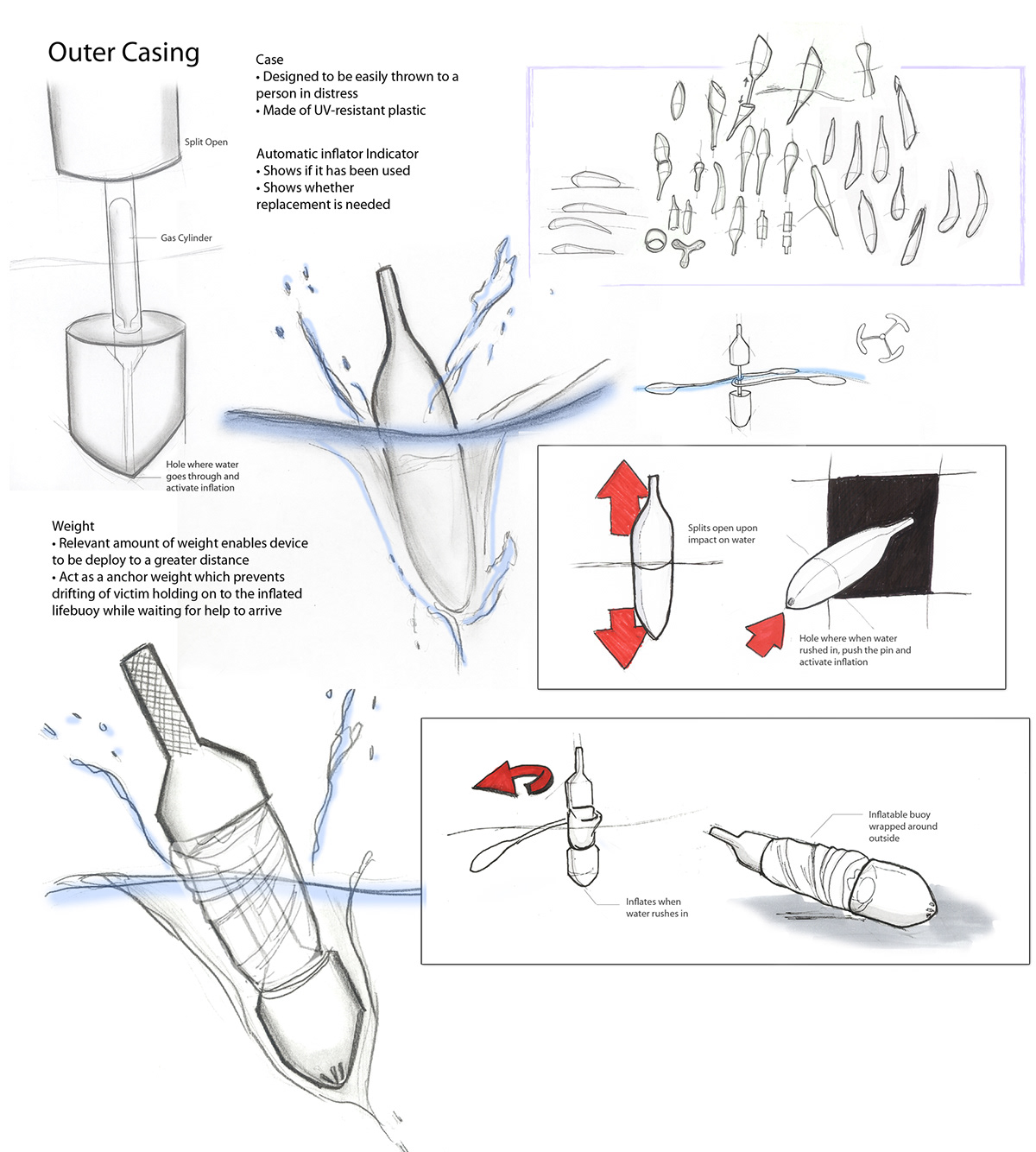
Exploration of Mechanism
I. Hidden Mechanism
• Upon impact of water, water rushed in from the hole at the bottom, pushes the pin and activates inflation.
II. Exposed Mechanism
• Upon impact of water, water rushed in from the hole at the bottom, dissolves the dissolving pill to release potential energy of the pin, triggering inflation.
I. Hidden Mechanism
• Upon impact of water, water rushed in from the hole at the bottom, pushes the pin and activates inflation.
• Casing splits open to allow the inflatable buoy to inflate.
Considerations
• There might be the probability of mechanism malfunction.• Water pressure might not be great enough to trigger inflation.• However, the hidden mechanism prevents abuse of device on shore.
II. Exposed Mechanism
• Upon impact of water, water rushed in from the hole at the bottom, dissolves the dissolving pill to release potential energy of the pin, triggering inflation.
• Inflatable buoy inflates immediately.
Considerations
• Exposing inflatable buoy allows immediate inflation yet it may be susceptible to weather conditions.• Easy maintenance of device. Dissolving pill to be replaced. Inflatable buoy to be wrapped on the outer of the device.
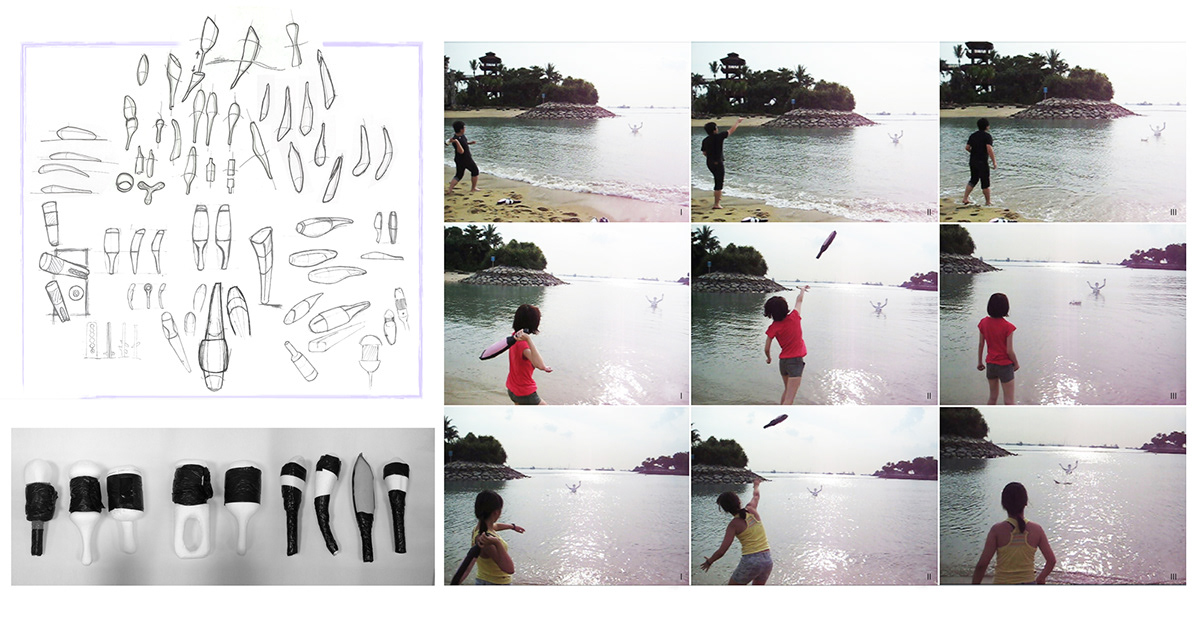
User Testing of Compacted Lifebuoy
A cardboard model of victim is placed 20 meters away from shore secured by an anchor. Various forms that are explored on are brought for user-testing.
Findings:
A cardboard model of victim is placed 20 meters away from shore secured by an anchor. Various forms that are explored on are brought for user-testing.
Findings:
• An average weight of 400 grams enables easy manipulation from passersby
• A symmetrical form enables passersby to throw and aim more accurately to the victim
• A singular handle is more intuitive for the manipulation of a inexperienced passerby
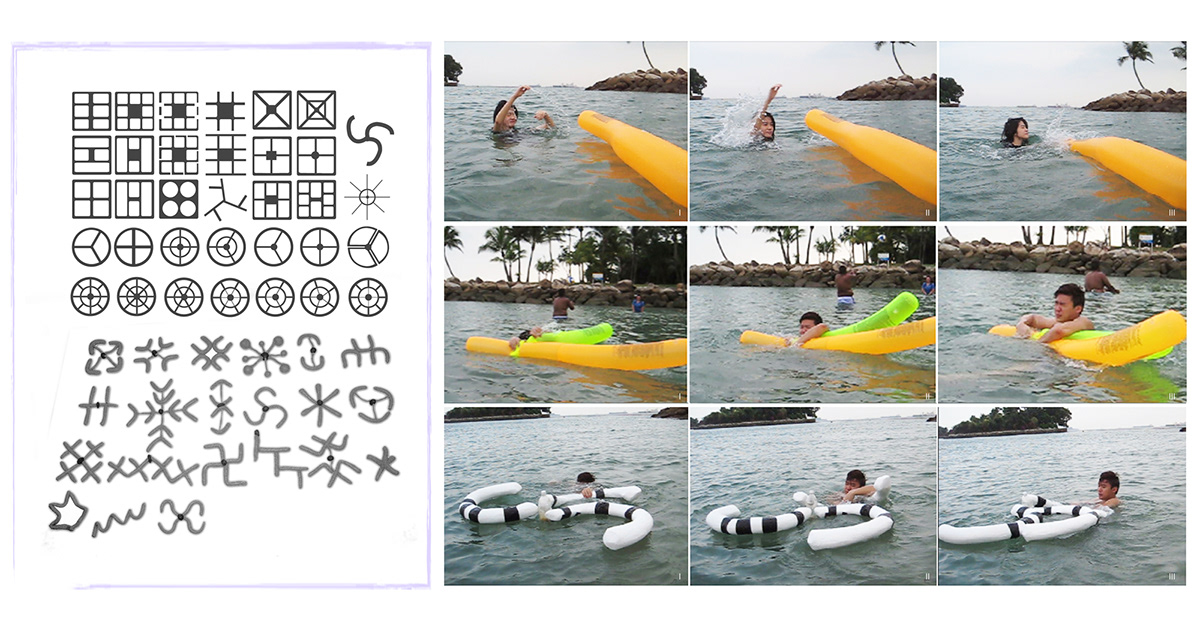
User Testing of the Inflatable
Various forms are explored on and brought for user-testing.
Findings:
Various forms are explored on and brought for user-testing.
Findings:
• A structural form is important to ensure the stability
• The surface area covered by the inflatable affects the possibility of the victim grabbing hold of the aid. However there is the limitation of the gas input by the standard gas cylinder.
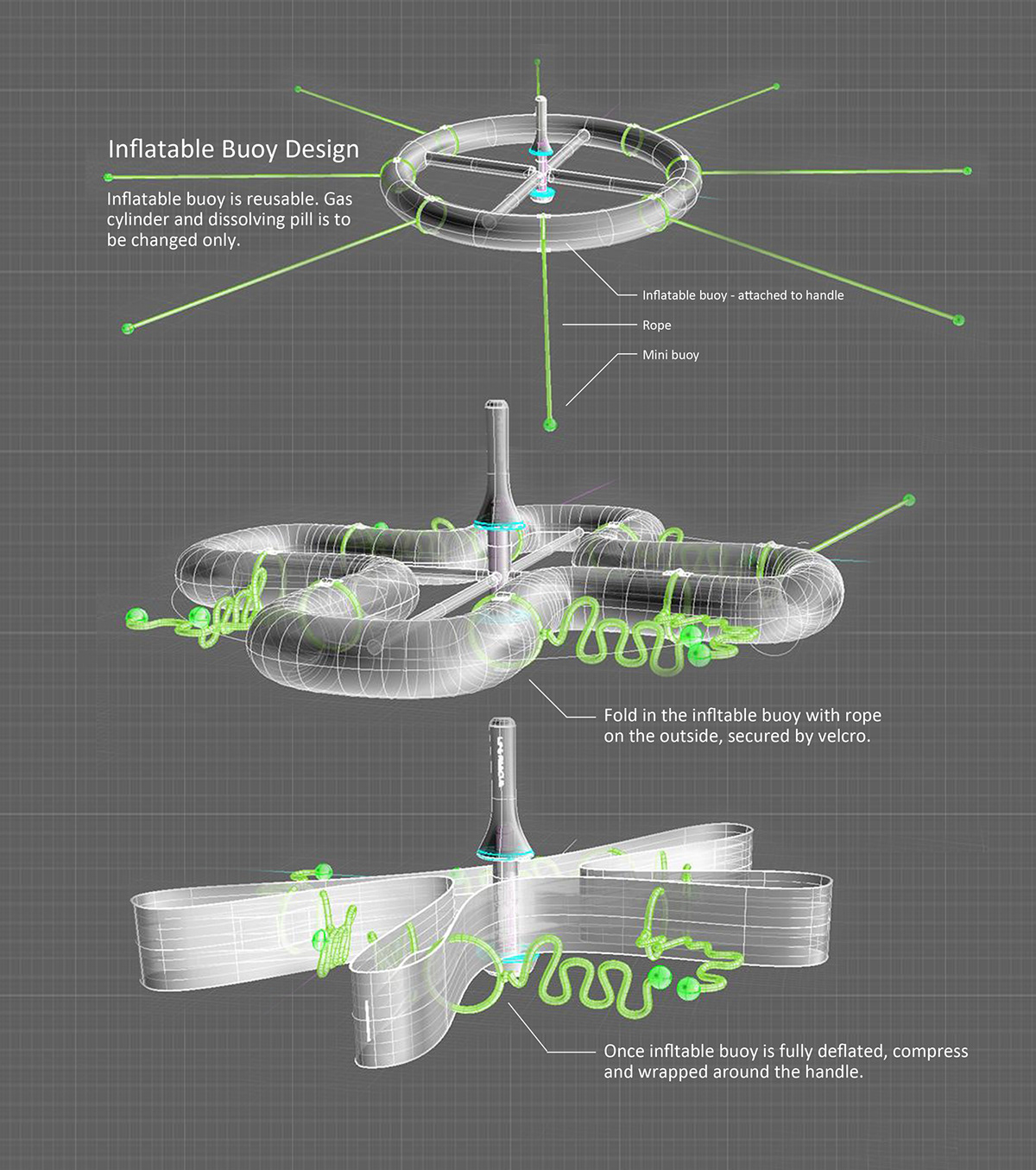
Inflatable Design Considerations
Polyurethane-coated nylon fabric
Automatic inflator mechanism
Polyurethane-coated nylon fabric
• Long service life
• High safety
• Used for inflatable life vests
Automatic inflator mechanism
• Activated when comes into water
• Robust and reliable
• Takes only a few seconds until it is fully inflated
• Equipped with a 60g CO2 cylinder and has a buoyancy of 150N
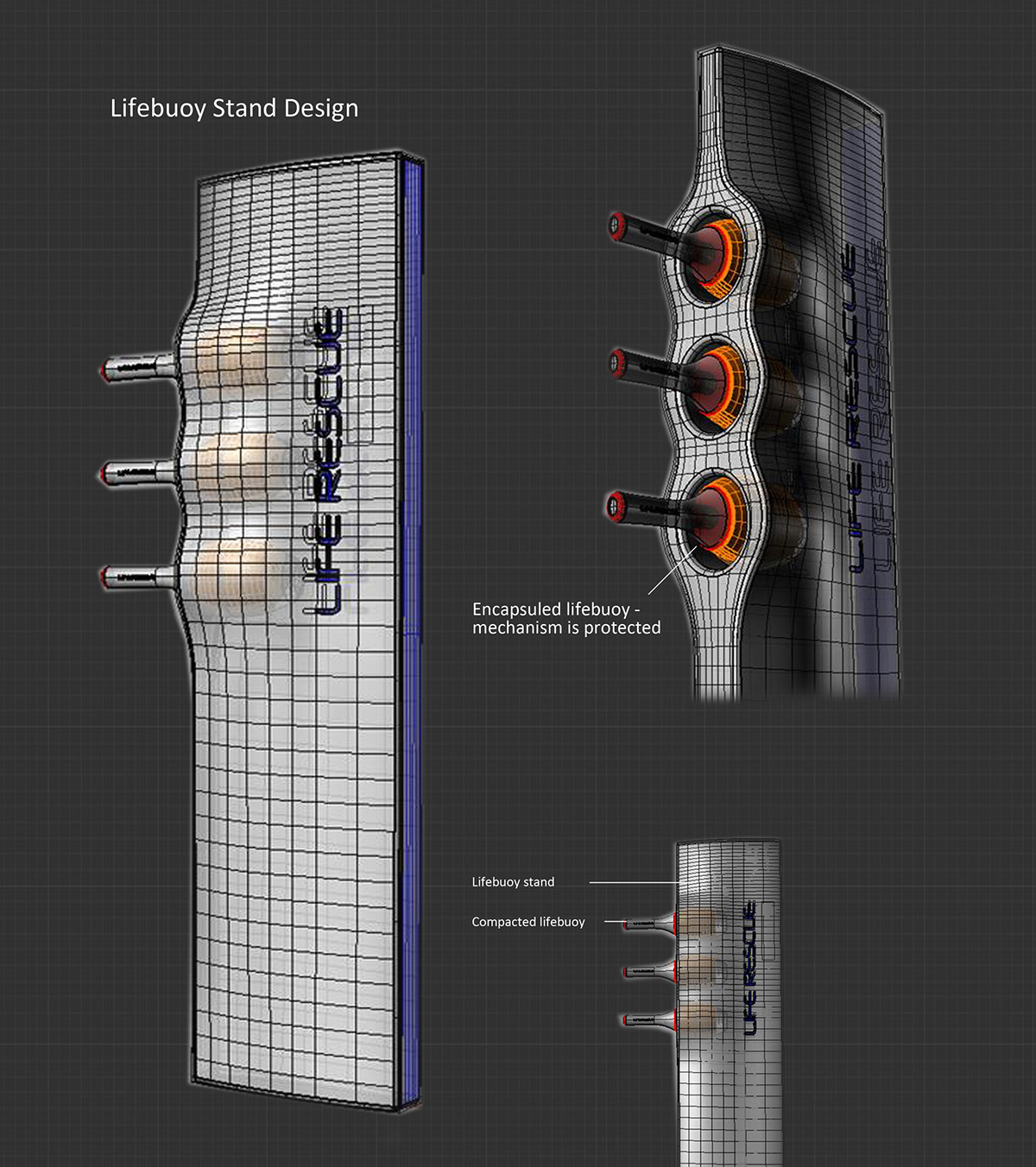
Lifebuoy Stand Design Considerations
Placement of three lifebuoys within a lifebuoy stand with reference to the user testing. The passersby are able to throw the compacted lifebuoy to a distance. In prevention of incidents where throws are not accurate, the lifebuoy stand provides three chances of throw. It is taken into consideration that from the first throw, an emergency signal has already been sent. During the night, lighting illuminates the lifebuoy stand.
Membrane inspired design encapsulate the compacted lifebuoys, using a minimal design to create a prominent attention during emergencies.
Placement of three lifebuoys within a lifebuoy stand with reference to the user testing. The passersby are able to throw the compacted lifebuoy to a distance. In prevention of incidents where throws are not accurate, the lifebuoy stand provides three chances of throw. It is taken into consideration that from the first throw, an emergency signal has already been sent. During the night, lighting illuminates the lifebuoy stand.
Membrane inspired design encapsulate the compacted lifebuoys, using a minimal design to create a prominent attention during emergencies.
